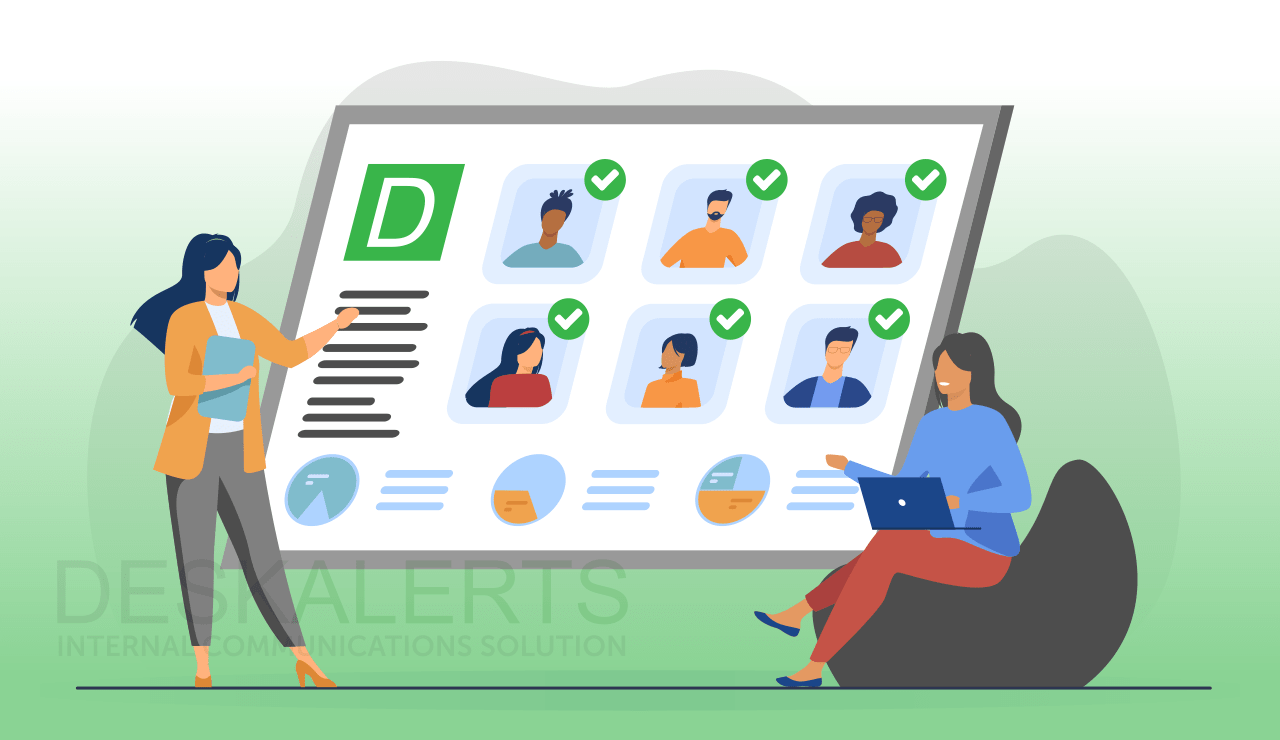
When employees are disengaged in the workplace, it can be a disaster for your organization’s bottom line. Disengaged employees can cost you big in terms of productivity and profitability and a whole raft of associated problems. Overcoming this issue, however, will require hard work and dedication as the way to increase employee engagement is often complex.
What is employee engagement?
In a nutshell, employee engagement describes the way in which employees feel passionate about their job, the organization they work for, and the contribution they make to seeing it succeed. It’s an important element in driving a business forward. When employees are engaged, they understand the company’s goals and what their individual role plays in meeting them.
When a company has an engaged workforce it simply works better overall. Employees work together collaboratively. Productivity is boosted. Morale is improved. People are less likely to leave the organization and the top talent in your industry will seek your organization out as an employer of choice. Profitability will increase – and you will find that you may also out-perform your competition.
Achieving this perfect blend of harmony in the workplace isn’t straightforward. Around the world right now, employee engagement in many companies is in a state of flux.
According to recent research from Gallup, there were unprecedented fluctuations in workplace culture in 2020 during the COVID-19 pandemic.
While the overall rate of engaged employees is 39% as of early 2021, it had dropped in the middle of last year to the lowest level since the year 2000 (31%).
The percentage of employees who are considered “actively disengaged” (these are the employees who have a thoroughly miserable experience in the workplace) is 14%.
The importance of engagement metrics
You can’t fix something if you don’t know what it is that you need to improve. Having data will help to identify any weaknesses so that you can formulate and implement mitigation strategies to determine how to increase employee engagement.
When you measure employee engagement there are many benefits, including:
- Being able to identify and deal with emerging issues as they’re developing instead of fixing them when they’ve gotten out of hand.
- Retaining the best employees that you have – especially in a work environment where people no longer have a “job for life” mindset and are always seeking new opportunities.
- Driving improvements in morale and teamwork.
- Identify areas for improvement across your organization, whether it be time efficiencies, cost-saving opportunities, or knowledge and training gaps.
- Being able to identify the unique strengths of your organization as well.
- Identifying issues in your work environment.
One of the best ways to measure employee engagement via employee engagement surveys. These are surveys that are specifically developed to measure various metrics such as performance, strategic alignment with goals, employee satisfaction, morale, and employee competence.
In order to provide useful and meaningful results, your employee engagement surveys should be sent out at periodic intervals following an initial benchmarking survey. This way you can chart your progress and determine if things are improving, staying the same or getting worse.
Qualitative data from employee engagement surveys should be used in conjunction with other data that your organization keeps. This can include the responses from exit interviews, anonymous or formal HR complaints and, employee retention rates (including on average how long people stay in their jobs).
When you analyze your data together you can get a “big picture” look at what is happening across the board in your organization to determine how to improve employee engagement.. You may find, for example, engagement is lower in particular teams, branches or departments compared with others. Armed with this knowledge, you can tailor appropriate strategies to boost engagement.

16 ideas to improve employee engagement in your workplace
Understanding the level of engagement in your workplace it just the beginning. Once you’ve measured your engagement levels, its time to implement various employee engagement solutions that will have an impact on your workforce.
1. Start at the top
You need buy-in from management at all levels in order to implement strategies to improve employee engagement. This is critical – if your management team doesn’t support any of the initiatives you are implementing to boost engagement, it will be a waste of time and money. Managers who say they don’t have time for this type of thing, who mock it or who act in ways that is not consistent with the goals you want to achieve are actually undermining this work.
Bad managers could have contributed to low levels of engagement in the first place. They need to shape up or ship out. Identify weaknesses in your managers people and communication skills and train them accordingly, for example by delivering emotional intelligence training
2. Create a psychologically safe workplace
According to the 2020 Progressive People & Culture Report from Macquarie University in Australia, organizations need to develop the right cultural conditions in the workplace where employees can feel psychologically safe.. This might require a complete overhaul of the way you work, but people need to feel like they can be free to speak up or free to make mistakes without reprisals. The research found that organizations that provide their employees with a psychologically safe work environment are 33% more likely to have a better performance on the stock market than organizations that don’t. This can be attributed to employees being free to be creative and innovative, driving growth as a result.
3. Pay attention to your employee onboarding experience
When new employees join your team, you need to make a good first impression on them as well as the other way around. Unfortunately, many people have terrible experiences when joining a new organization. They might not be given appropriate orientation, don’t have the right tools and equipment to start working, or could be told inconsistent information from different co-workers.
Designing an onboarding program that is delivered to every single new hire will help provide some uniformity and show that you are an employer committed to giving them what they need to excel and shine. It will not only help them to feel welcome but will let them know where to access resources and articulate expectations and responsibilities.
4. Consider using an employee experience platform
There are lots of different software solutions for lots of different engagement issues. An employee experience platform is a user-centric software platform designed for employees – not necessarily for HR departments. The goal is to have employees operating in an IT environment that is easy to use, enables them to access files and apps they need quickly, and helps them stay connected to their colleagues.
Peoples’ preferences are shifting and nowadays they expect the same quality of IT experience in their work-life that they have in their personal IT usage...
Recent research from Zapier found that 16% of Millennial and Generation Z employees have quit jobs because they felt their employer-provided inadequate technology!
5. Focus on work/life balance
In 2019, before the modern workplace was turned on its head because of COVID-19, the World Health Organization updated its handbook of diseases to include burnout as an occupational phenomenon. It recognizes a growing prevalence for people to work too much and not have enough time spent on recreation or relaxation. The result is mental health problems, fatigue and even physical health issues manifesting.
Burnout has become more problematic during the pandemic. For example, employees working remotely from home are finding the line between home and work is being blurred. Time normally spent commuting is being spent on extra work, and as such remote employee engagement should be factored into your efforts.
Occupations such as healthcare are experiencing burnout and psychological distress at much higher rates. It’s important to find solutions and provide guidance to employees to recognize burnout and what they can do to overcome or prevent it.
6. Provide perks with wellbeing benefits
Providing employees with perks is always one of the best strategies to improve employee engagement. There is a range of perks specifically designed to improve mental health and physical wellbeing that can help drive engagement even further. Ideas include:
- Free or subsidized gym memberships.
- Free healthy catered lunches.
- Freedom to work from home.
- Extra vacation days.
- Allow time for personal projects.
- Access to wellness programs.
- Access to counseling services.
7. Provide a range of different learning and development opportunities
A 2019 report from LinkedIn found that 94 percent of employees said they would stay with a company if it invested in learning. This means doing more than just onboarding your employees or training them in new tools or procedures that you are implementing in the workplace.
Consider paying for training and qualifications that will help to up-skill your employees so that they can move into more senior positions within the organization. Conferences are a good way for them to network with their contemporaries elsewhere in the industry.. Coaching and mentoring opportunities within the organization, or externally, are also good to provide specific, tailored advice that grows an individual employee. Another idea is job shadowing where the employee gets to work alongside a senior employee or someone in another part of the organization to gain insights into what they do.
8. Offer praise
It might seem small and insignificant, but the truth is people like to be acknowledged when they’ve done something well. When an employee does something great, tell them… and do it in front of others if you can! This is a very simple and practical example of how to increase employee engagement in any organization.
9. Send motivational quotes
Sometimes sending a motivational or inspirational quote can be just what someone needs to see in order to boost their mood and get them going for the day. Of course, this isn’t for everyone so use it sparingly if you have team members who don’t enjoy it.
>> Read how to deliver motivational messages to employees and download 38 samples <<
10. Encourage social activities
One of the best ways to boost teamwork is for employees to get to know one another in a setting away from their desks and work talk. This is particularly useful if you have a large organization with lots of separate work teams that may not come together very often – even if they do need to collaborate on occasion. When you have good relationships, you have better communication and better outcomes.
Organizational psychologists agree.
Iт fact, a survey by Globoforce found that the more friends people have in the workplace, the more committed they felt towards the company.
Only 24% of respondents with no work friends said they loved their company, compared with 71% who had more than 25 work friends.
Social activities can include after-work drinks, morning or afternoon tea and coffee sessions, walking groups, book clubs and other hobbies/discussion groups that can meet at lunchtime or before/after work.
11. Establish a culture committee
Select ambassadors from different departments within your organization who will model the core values and ensure that your desired corporate culture is being implemented. This committee can come together to share news/get advice on how to improve things in their teams in order to ensure consistency across the organization and break down silos.
12. Try new internal communication channels
Good internal communication has been found to be one of the key drivers of increased employee engagement. It stands to reason that when employees have clear, relevant, timely information they are better informed to do their jobs and to understand the reasoning behind management decisions and policies. Unfortunately, many organizations struggle with this and employees will say that internal communication is poor within their company.
And in many cases isn’t through lack of trying…it might just be that the channels being used are ineffective. Email, for example, is the go-to in most workplaces for communicating. Unfortunately, because inboxes are overloaded, important information may never be seen. Try different ways of cutting through the digital noise to deliver information to employees. For example, pop-up notifications, screensavers, wallpapers, digital signage or employee apps.
13. Lunchtime seminars
This is different from other learning and development opportunities mentioned above. These seminars could be on a range of popular topics, such as personal finance, sustainability or mindfulness with outside experts coming in to speak to employees. They could also be used by employees to speak on topics they are passionate about, such as showcasing their hobbies or volunteer work.
14. HAve ‘stay’ meetings instead of exit interviews
This idea to improve employee engagement goes against the grain. By the time you’re having an exit interview with a valued employee, they’ve decided to move on to greener pastures and it is highly unlikely you could persuade them not to leave at this juncture. A ‘stay’ meeting, on the other hand, is a semi-regular check-in with employees to ensure they are happy so that they don’t go looking for another job. This includes work conditions, salary, training and development, and workplace culture.
15. Ensure new hires are a good cultural fit
If you’ve spent a lot of time and effort building the ideal workplace culture, you can quickly undo it by recruiting the wrong people to the organization. What this means is that as well as specific job-based skills and competencies, you need to recruit people who have attitudes that align with you. Your corporate values.
And of course, it goes the other way too: if you have a poor workplace culture, you’ll quickly lose your new recruits.
Research from Robert Walters found that 73% of professionals gave left a job because they did not fit the culture.
16. Volunteer or fundraise together
A good way to unite your team is to find local volunteer opportunities where you can all commit to making a difference together for something that isn’t specifically related to your work. You can also raise funds for a cause if you can’t mobilize everyone to volunteer.

Strategies to increase employee engagement
The above ideas should get you started thinking about different ways you can increase employee engagement within your organization. However, you will need to have strategies in place to help guide your actions. This includes:
1. A strategy for employee engagement communications
There are many reasons to have a good internal communication strategy in place to help boost engagement. Not only is it important to improve internal communication overall, but you’ll want to also have a strategy that helps you to communicate your various engagement-related initiatives.
Unfortunately, 60% of organizations don’t have an internal communications strategy at all, according to a survey conducted by Arthur J Gallagher and Co.
Your internal communications strategy should outline your key messages, the frequency of communication, the channels you will use to communicate, who is responsible and budget if appropriate.
2. A health and wellbeing strategy
There are clear links between employee health and wellbeing and employee engagement. A strategy for improving health and wellbeing can help to identify and negate common workplace health issues such as burnout. But it can deliver much more than that. Employee assistance programs can help employees with professional and personal problems. Helping employees access healthy eating and exercise programs can also make a huge difference. In addition to improvements in engagement, you should also see declines in absenteeism.
3. Openness and inclusiveness policies
Ensure that your workplace culture is one that fosters openness and inclusiveness by developing policies and guidelines for managers to be more transparent and accountable. This can include employees providing feedback in a safe way or having an “open door” policy where employees are encouraged to approach their manager at any time to share their opinion.
4. Rewards and recognition programs
Rewarding and recognizing good work is essential to improving employee engagement levels When workers feel as though they aren’t acknowledged or taken for granted it can affect morale… and see them looking for a new place to work where they will be valued. Research by Employee Gateway found that almost half of employees said that they would leave an organization that didn’t thank or praise them enough for their work. And Deloitte research found that organizations that recognize their employees experience 14% higher engagement levels and productivity than those that don’t recognize their people.
The role of HR and management in engagement
HR departments have a key role to play in helping to shape and deliver employee programs designed to boost engagement. This includes designing and delivering employee engagement and pulse surveys. HR managers also need to be leaders in measuring and evaluating the results of any data – particularly when it comes to policies and procedures around recruitment, retention, training, and health and wellbeing programs.
However, the HR department’s role in ensuring the success of these initiatives is limited. Managers need to embrace the new practices at the coal face to ensure success. A lot of people leave a job because of a manager, even if they like the company as a whole.
Managers need to be empowered to take on these added responsibilities, including through training but also by having the right tools to do their jobs.
Studies have also found that when employees have positive relationships with their managers or direct supervisors, there is a positive correlation with employee engagement as well.
***
As the saying goes, your employees are your company’s greatest assets. It stands to reason that looking after them should be a corporate priority, and your driving force in determining how to improve employee engagement. . Making improvements that enhance engagement levels will see you build a collaborative workplace where employees feel they are valued an contribute to success in a meaningful way.
 Caroline Duncan
Caroline Duncan








